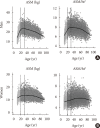Sarcopenia, Frailty, and Diabetes in Older Adults
- PMID: 27098509
- PMCID: PMC4929221
- DOI: 10.4093/dmj.2016.40.3.182
Sarcopenia, Frailty, and Diabetes in Older Adults
Abstract
Populations are aging and the prevalence of diabetes mellitus is increasing tremendously. The number of older people with diabetes is increasing unexpectedly. Aging and diabetes are both risk factors for functional disability. Thus, increasing numbers of frail or disabled older patients with diabetes will increase both direct and indirect health-related costs. Diabetes has been reported as an important risk factor of developing physical disability in older adults. Older people with diabetes have lower muscle mass and weaker muscle strength. In addition, muscle quality is poorer in diabetic patients. Sarcopenia and frailty have a common soil and may share a similar pathway for multiple pathologic processes in older people. Sarcopenia is thought to be an intermediate step in the development of frailty in patients with diabetes. Thus, early detection of sarcopenia and frailty in older adults with diabetes should be routine clinical practice to prevent frailty or to intervene earlier in frail patients.
Keywords: Diabetes; Disability; Frailty; Sarcopenia.
Conflict of interest statement
Figures
References
-
- The Population Reference Bureau: 2014 World population data sheet. [cited 2016 Feb 27]. Available from: http://www.prb.org/pdf14/2014-world-population-data-sheet_eng.pdf.
-
- Cruz-Jentoft AJ, Baeyens JP, Bauer JM, Boirie Y, Cederholm T, Landi F, Martin FC, Michel JP, Rolland Y, Schneider SM, Topinkova E, Vandewoude M, Zamboni M European Working Group on Sarcopenia in Older People. Sarcopenia: European consensus on definition and diagnosis. Report of the European Working Group on Sarcopenia in Older People. Age Ageing. 2010;39:412–423. - PMC - PubMed
-
- Abellan van Kan G. Epidemiology and consequences of sarcopenia. J Nutr Health Aging. 2009;13:708–712. - PubMed
-
- Kim KM, Lim S, Choi KM, Kim JH, Yu SH, Kim TN, Song W, Lim JY, Won CW, Yoo HJ, Jang HC Sarcopenia Study Group of Korean Geriatrics Society. Sarcopenia in Korea: prevalence and clinical aspects. J Korean Geriatr Soc. 2015;19:1–8.
-
- Fried LP, Guralnik JM. Disability in older adults: evidence regarding significance, etiology, and risk. J Am Geriatr Soc. 1997;45:92–100. - PubMed
Publication types
LinkOut - more resources
Full Text Sources
Other Literature Sources


